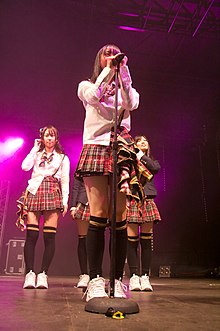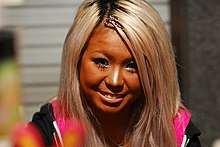Kogal

Kogal ( Japanese コ ギ ャ ル , kogyaru ) describes a subculture of girls and young women in Japanese metropolitan areas that emerged in the 1990s . It is defined by the consumption of validity, i.e. the demonstrative display of available income through particular musical tastes, clothing and social behavior. In Japanese society, this subculture is viewed as gross and tasteless. The girls refer to themselves as Gyaru ( gal ), although this also includes other related subcultures and Kogal is more associated with school girls.
In Japan, the Kogal style is also known as Yankee (a term for non-conformist youth), although this term can also be applied to men.
origin of the name
The origin of the term Kogal is disputed. The most popular theory derives it from the Japanese word for high school ( kōkō ), while others see it in connection with ko (子), the Japanese word for "child". The second part gal is a slang term for “girl” or “brat”.
Appearance
In general, the Kogal look is similar to that of a Californian “Valley girl”. In fact, the similarities extend to a scene jargon with a variety of slang terms ( コ ギ ャ ル 語 , kogyaru-go , "Kogal language"). Kogal should not be confused with the similar Ganguro subculture.
Kogal wear platform shoes, mini skirts, designer accessories, a lot of makeup, as well as the use of hair dyes and sometimes also tanning agents. For school uniform they wear most ambitious skirts and loose socks (large, wrinkled socks). Their busy social life and their craving for new material goods make them top consumers of the Japanese mobile phone industry , while their fashion tastes lean towards Burberry scarves and Louis Vuitton handbags. Kogal spend a lot of time shopping, which devours a lot of their time and income (and that of their parents).
The center of the Kogal culture lies in the district of Shibuya in Tokyo , particularly in the department store "Shibuya 109", as well as any other Japanese city has a small-Kogal group.
A minority of Kogals finances their habits through pornography, a probably larger part practices Enjokōsai ("Temporary accompaniment"), which sometimes borders on prostitution. The way the word is used on the Internet has led to the misconception that Kogal equates to prostitutes.
The Kogal phenomenon is still popular, although clothes and hair color are increasingly adapting to conservative tastes.
Movies
- Bounce Ko Gals ( バ ウ ン ス ko GALS) (1997) - a film by Masato Harada
- Gals! - Anime series about the life of Ran Kotobuki, the self-proclaimed "Greatest gal in Shibuya"
- Hajimete no Gal - Manga / Anime about a nerd with a Kogal friend and other Kogals of all kinds

